The Lenovo ThinkPad X1 Carbon Review (2015)
by Brett Howse on May 21, 2015 8:00 AM EST- Posted in
- Laptops
- Lenovo
- ThinkPad
- Ultrabook
- Broadwell-U
System Performance
The review unit that I received should be no slouch for performance, since it has the Intel Core i7-5600U processor. We have seen a few Broadwell powered notebooks already this year, including Core M and Core i5 models, but this is the first Core i7 that has come across my desk. The i7-5600U is a dual-core processor with Hyperthreading, and it has a base frequency of 2.6 GHz and turbo of 3.2 GHz. All of this processing occurs within a 15 watt TDP.
The memory is 8 GB of DDR3L-1600, and it is in dual-channel mode. Graphics are the Gen 8 Broadwell graphics with 24 Execution Units and the GPU is 300-950 MHz.
The final piece of the performance puzzle is storage, and this X1 Carbon has the fastest SSD available for a laptop in it. The Samsung SM951 drive is a 512 GB PCIe SSD, and despite the lack of NVMe in this particular model it is a potent offering. Kristian reviewed the SM951 in great detail so if you want all of the particulars, check that out.
Performance Graphs
For performance workloads, the X1 Carbon was run through our standard laptop workload. For comparison, I have chosen a sample of other Ultrabooks and other similar devices like the Surface Pro 3, and I have also included the 2013 X1 Carbon as well which had the i5-3427U processor, but if you would like to compare the X1 Carbon to any other device we have tested, please use our Laptop Bench. I have seen some questions about why some devices are not included in all of the results, and it boils down to our benchmark workloads are always evolving, so older devices would not have been run through some of the newer workloads. We do not get to keep all of these devices in order to go back and re-run older ones through the new workloads.
PCMark
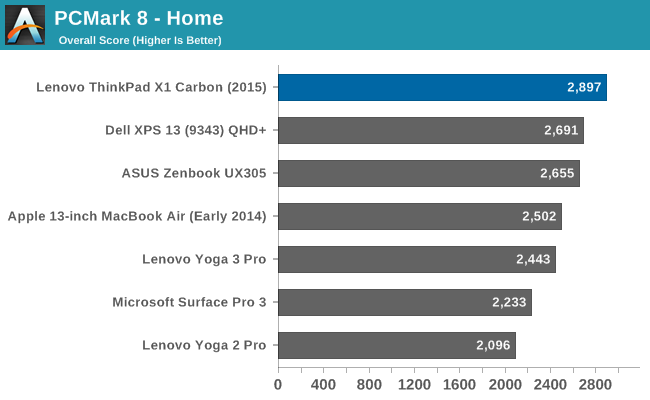
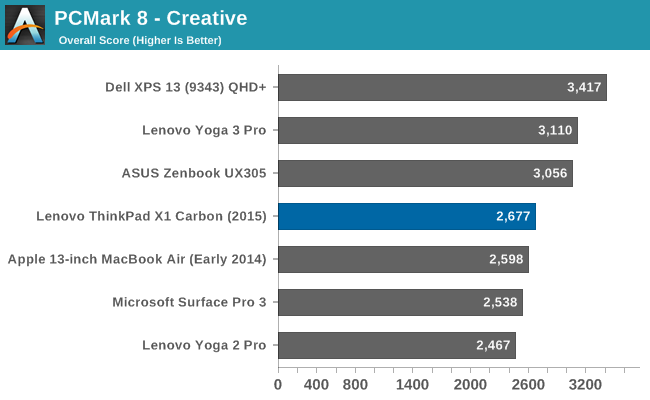

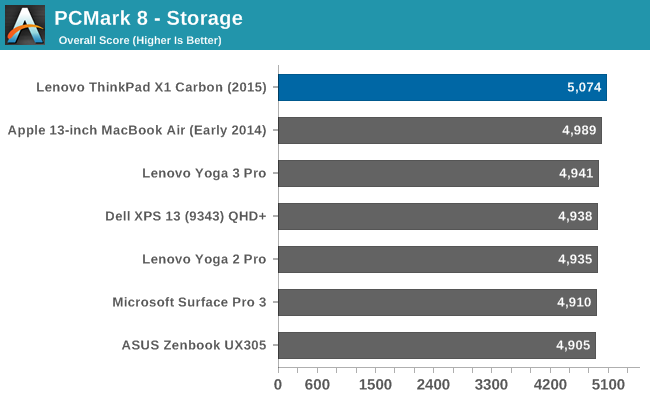
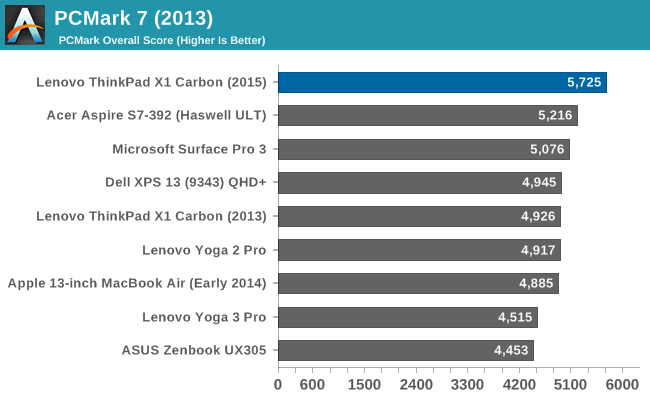
PCMark tries to replicate real world use scenarios with its various workloads. It will have sustained performance as well as burst performance requirements, and storage is also a factor in the scores. Overall, the X1 Carbon aces these tests with its combination of i7 processor and PCIe SSD. The PCMark storage score shows the X1 Carbon as the fastest device we have tested, but due to the nature of the benchmark the scores are all very close to each other. Make no mistake though. This is a drive that can read at 1500 MB/s. For a full breakdown on the drive, please check out Kristian’s review linked at the top of this page.
Cinebench

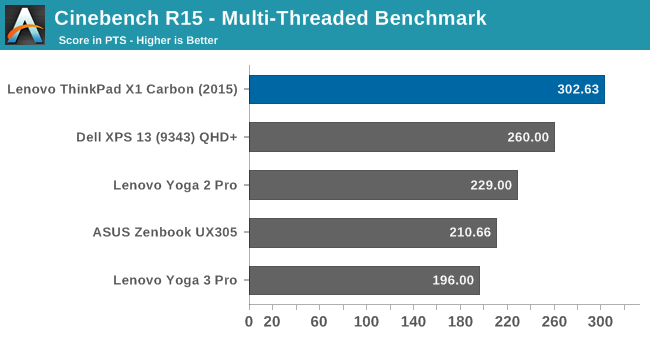
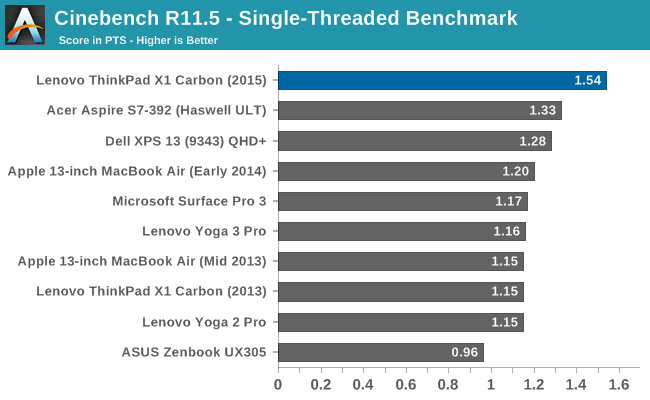
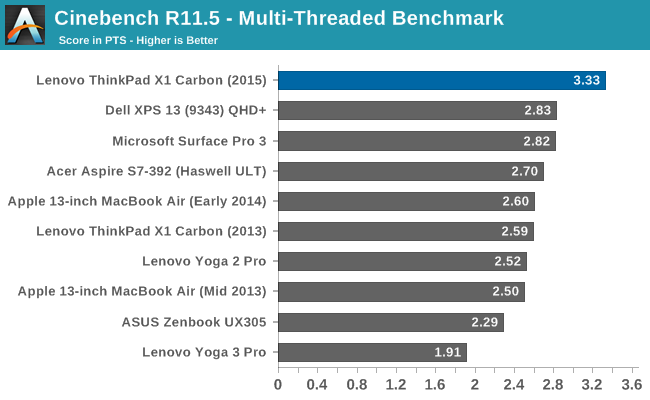
Cinebench renders an image, and can leverage multiple cores. It loves IPC and frequency, both of which the i7 has in abundance, so the X1 Carbon sits at the top.
x264
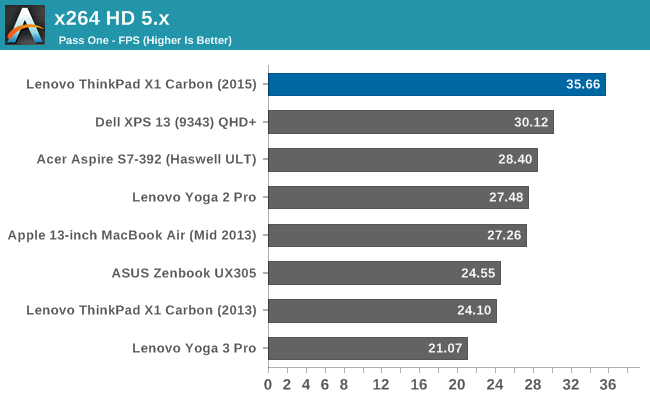
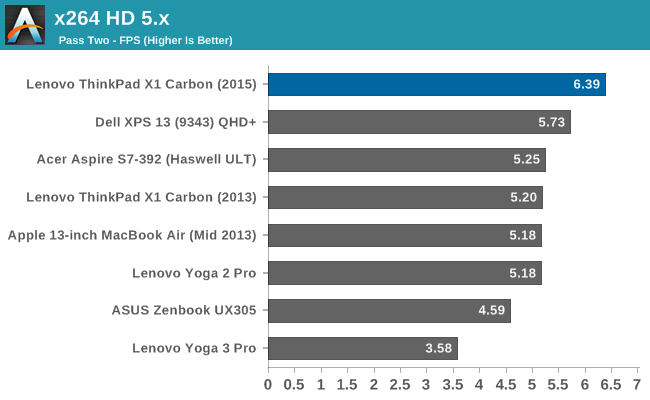
This test converts several videos, and much like Cinebench it loves more cores and higher speeds. The i7-5600U easily passes all over U class notebooks we have tested in this test. This test is all about sustained performance, since it can last an hour or more.
Web Tests
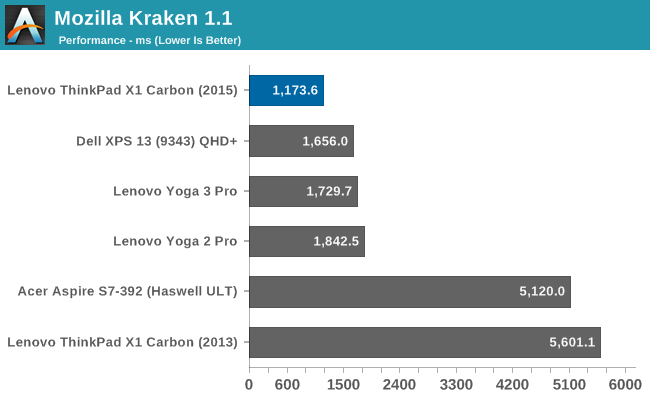
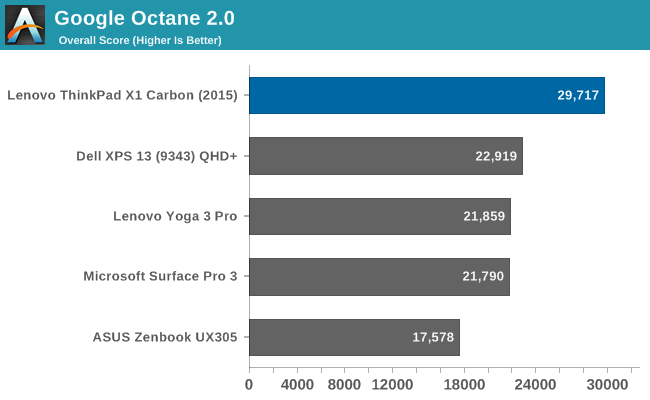
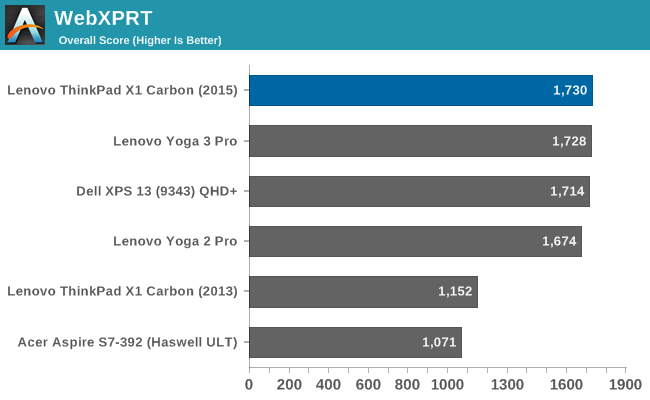
With a 3.2 GHz turbo frequency, the i7-5600U has no issues with javascript. As you can see in these results, it is by far the fastest Ultrabook tested in these kinds of short workloads.
System Performance Conclusion
With 8 GB of memory, a Core i7 processor, and the fastest consumer SSD available, day to day tasks on the X1 Carbon are done with ease. This is easily one of the fastest Ultrabooks around when configured as the review unit is. I don’t love that the base model comes with just 4 GB of memory, but the cost to move to 8 GB is not a lot and should be done by all prospective buyers. I’m not sure if we are at the point where 16 GB of system memory would be needed in an Ultrabook, but it likely will not be long before that does happen.










103 Comments
View All Comments
Brett Howse - Thursday, May 21, 2015 - link
No I don't think so :) But if you do need to be able to run one over, you could get one of these http://www.business.panasonic.com/fully-rugged-lap...fokka - Thursday, May 21, 2015 - link
i agree with most things here. 4gb of RAM isn't acceptable in an ultrabook of the thinkpad brand in 2015 and neither is a TN panel. at least the days of 900p displays are over now and i prefer the 1440p display with rgb stripe to 1800p panels using some kind of pentile matrix.still, for a "professional"-grade ultrabook, which might also be used outside the office, the display is much too dim. under 300nits is a bad showing imho and with ever more efficient displays and LEDs, i would like to see more models approaching the 400nits-mark, instead of struggling to get 300.
i'm also wary of the 128gb starting config, if you ask me there should only be options from 256gb-1tb, but i guess you got to meet the lower price points somehow as well.
i'm glad lenovo came to their minds in regard to the function keys and the track pad buttons, but while they improved battery life, it still is mediocre at best. i think 50wh in a 14-inch form factor that is neither especially thin, nor has remarkably thin bezels is simply too little. 60wh would be much nicer, offering 20% more runtime, and looking how dell stuffs 52wh inside the "miniscule" xps13, 60wh should be manageable on the x1.
regarding I/O the options could be better too. two usb3 ports is the bare minimum i would expect from a thinkpad and opting for a dedicated ethernet extender port doesn't seem like the greatest idea, if you could reach the same goal with another usb port plus ethernet adapter. using usb type-c would be even better for that and you could use it for the docking port as well.
in the end it is a nice and fast machine, that's not cheap when configured properly, that is a big step up from the last iteration (but how could it not be?), but with some mediocre scores when it comes to display and runtime.
for the money one can spend on a higher end x1 i would at least like to see those two main flaws sorted out, otherwise it is a quite nice machine.
meacupla - Thursday, May 21, 2015 - link
Lenovo always lags behind others when it comes to panels offered.It's like they are purposefully obtuse about upgrading product lines to newer hardware, or are trying to make more money by skimping on their top tier products.
I really don't know of any other 'reputable' company that does this with their high end products.
edzieba - Thursday, May 21, 2015 - link
The dock you have pictured is the regular OneLink dock. The OneLink Pro dock has a DVI port in place of the HDMI, adds an extra DisplayPort output, and adds a pair of USB3 ports on the rear.Brett Howse - Thursday, May 21, 2015 - link
Fixed sorry about that!Essence_of_War - Thursday, May 21, 2015 - link
RAM is soldered down, but is the SSD soldered to the logic board also, or is that potentially end-user replaceable?Kristian Vättö - Thursday, May 21, 2015 - link
The SSD is replaceable, that's how I got early access to the Samsung SM951 in the laptop ;-)Essence_of_War - Thursday, May 21, 2015 - link
Good to know that drive failures can be addressed in-the-field!Michael Bay - Thursday, May 21, 2015 - link
I think Lenovo and bad display panels now are more or less synonymous, in notebooks at least.With prices as high as they are, would it kill them to put in something different from usual tn horrorshow for once?
der - Thursday, May 21, 2015 - link
Thank you Brett. Brett is love, Brett is life.